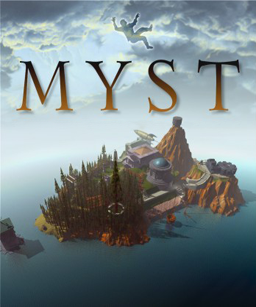
Myst is an adventure video game designed by the Miller brothers, Robyn and Rand. It was developed by Cyan, Inc., published by Broderbund, and initially released in 1993 for the Macintosh. In the game, the player travels via a special book to a mysterious island called Myst. From there, solving puzzles allows the player to travel to other worlds ("Ages"), which reveal the backstory of the game's characters and help the player make the choice of whom to aid. The player interacts with objects and walks to different locations by clicking on pre-rendered imagery.

Riven: The Sequel to Myst is a puzzle adventure video game, the second in the Myst series of games. Developed by Cyan Worlds, it was initially published by Red Orb Entertainment, a division of Broderbund. Riven was distributed on five compact discs and released for Mac and Windows personal computers on October 31, 1997, in North America; it was later released on a single DVD-ROM in 1998. Riven was also ported to several other platforms. The story of Riven is set after the events of Myst. Having been rescued from the efforts of his sons, Atrus enlists the help of the player character to free his wife from his power-hungry father, Gehn. Riven takes place almost entirely on the Age of Riven, a world slowly falling apart due to Gehn's destructive rule.

Uru: Ages Beyond Myst is an adventure video game developed by Cyan Worlds and published by Ubisoft. Released in 2003, the title is the fourth game in the Myst canon. Departing from previous games of the franchise, Uru takes place in the modern era and allows players to customize their onscreen avatars. Players use their avatars to explore the abandoned city of an ancient race known as the D'ni, uncover story clues and solve puzzles.

Pyst is an adventure computer game released in October 1996. It was created as a parody of the highly successful adventure game Myst. Pyst was written by Peter Bergman, a co-founder of the Firesign Theatre, and was published by Parroty Interactive, with Bergman, Stallone, Inc. as co-publisher. Mindscape began distributing the game on August 20, 1997. The parody features full motion video of actor John Goodman as "King Mattruss", the ruler of "Pyst Island". Versions of the game were produced for both the Windows PC and Apple Macintosh operating systems.
Myst is a franchise centered on a series of adventure video games. The first game in the series, Myst, was released in 1993 by brothers Rand and Robyn Miller and their video game company Cyan, Inc. The first sequel to Myst, Riven, was released in 1997 and was followed by three more direct sequels: Myst III: Exile in 2001, Myst IV: Revelation in 2004, and Myst V: End of Ages in 2005. A spinoff featuring a multiplayer component, Uru: Ages Beyond Myst, was released in 2003 and followed by two expansion packs.

Titanic: Adventure Out of Time is a 1996 point-and-click adventure game developed by CyberFlix and published in the United States and United Kingdom by GTE Entertainment and Europress respectively, for Windows and Macintosh. It takes place in a virtual representation of the RMS Titanic, with the player assuming the role of a British spy who has been sent back in time to the final night of the Titanic and must complete a previously failed mission to prevent World War I, the Russian Revolution, and World War II from occurring. The gameplay involves exploring the ship and solving puzzles. There are multiple outcomes and endings to the game depending on the player's interactions with characters and use of items.
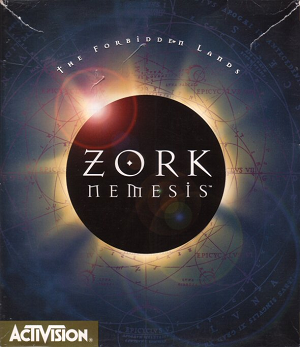
Zork Nemesis: The Forbidden Lands is a graphic adventure game developed by Zombie LLC, published by Activision, and released in 1996 for Windows 95, MS-DOS, and Macintosh. It is the eleventh game in the Zork series, and the first title not to be marketed under the Infocom label, while featuring a darker, less comical story within the Zork setting. The story focuses on players investigating the sudden disappearance of four prominent figures and their children to the hands of a mysterious being known as the "Nemesis", and uncovering a sinister plot during their investigations that they must thwart. The game features performances by Lauren Koslow, W. Morgan Sheppard, Allan Kolman, Stephen Macht, Paul Anthony Stewart, Merle Kennedy, and Bruce Nozick.

Microsoft Arcade is a series of classic arcade game compilations released by Microsoft between 1993 and 2000.

Zeus: Master of Olympus is a single-player strategy game developed by Impressions Games and published by Sierra Studios. It is considered to be an additional installment in the City Building series of games. Like previous titles in the series, Zeus focuses on the building and development of a city in ancient times. The game features a number of changes from previous titles in the series, including being set in Ancient Greece as well as changes to certain gameplay mechanics; however, it is considered to be in most aspects very similar to its predecessor, Caesar III.

Shivers is a single-player horror-themed PC adventure game, released on CD-ROM by Sierra On-Line in November 1995. It was developed with Sierra's Creative Interpreter. Being the first Sierra first-person adventure game, Shivers was compared to contemporary Myst and The 7th Guest, gaining praise mostly for its atmosphere. The game takes place in a fictitious haunted museum.

Rama is a first-person adventure game developed and published by Sierra On-Line in 1996. The game is based on Arthur C. Clarke's books Rendezvous with Rama (1973) and Rama II (1989) and supports both DOS and Microsoft Windows. In 1998, a PlayStation version was released in Japan. It is the second Rama game to be produced. The interactive fiction game Rendezvous with Rama was released in 1984 by Telarium.

Atlantis: The Lost Tales is a 1997 fantasy adventure video game developed and published by Cryo Interactive Entertainment. Interplay Productions published the game in North America, where it released on September 30, 1997. The game is named after its initial and most important setting, Atlantis. It is the first in a Myst-like series, and was followed by Atlantis II, Atlantis III: The New World, Atlantis Evolution and The Secrets of Atlantis: The Sacred Legacy.

Amber: Journeys Beyond is an American computer game released in 1996 for Apple Macintosh computers and Windows 95. It is the only game produced by Hue Forest Entertainment, founded by Frank and Susan Wimmer.
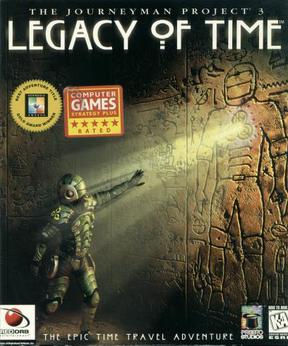
The Journeyman Project 3: Legacy of Time is a computer game developed by Presto Studios and is a sequel to The Journeyman Project and The Journeyman Project 2: Buried in Time.
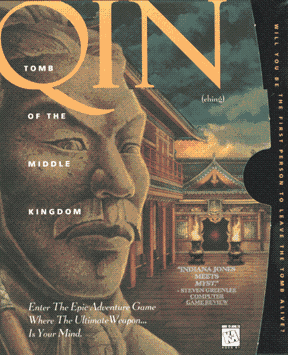
Qin: Tomb of the Middle Kingdom is a Myst-like graphic adventure computer game developed by Learn Technologies Interactive published by Time Warner Interactive and released for Windows and Macintosh systems.
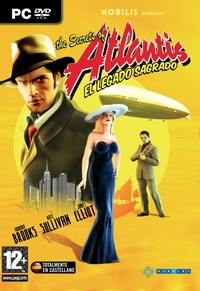
The Secrets of Atlantis: The Sacred Legacy is a 2006 graphic adventure game developed by the French studio Atlantis Interactive Entertainment and published by Nobilis. It is the fifth and latest game in the Atlantis series started by Cryo, and the second one made by Atlantis Interactive Entertainment, following Atlantis Evolution.

Drowned God: Conspiracy of the Ages is a 1996 science fiction adventure game developed by Epic Multimedia Group and published by Inscape. The game propounds the conspiracy theory that all of human history is a lie and that the human race's development and evolution were aided by extraterrestrials. The player attempts to uncover the truth through the course of the game by traveling to a variety of different worlds, interacting with historical and fictional characters, and solving puzzles.

Warcraft II: Tides of Darkness is a fantasy real-time strategy computer game developed by Blizzard Entertainment and released for MS-DOS and Microsoft Windows in 1995 and Mac OS in 1996 by Blizzard's parent, Davidson & Associates. A sequel to Warcraft: Orcs & Humans, the game was met with positive reviews and won most of the major PC gaming awards in 1996. In 1996, Blizzard released an expansion pack, Warcraft II: Beyond the Dark Portal, for DOS and Mac OS, and a compilation, Warcraft II: The Dark Saga, for the PlayStation and Sega Saturn. The Battle.net edition, released in 1999, included Warcraft II: Beyond the Dark Portal, provided Blizzard's online gaming service, and replaced the MS-DOS version with a Windows one.

Nemesis: The Wizardry Adventure is a 1996 adventure and role-playing video game developed and published by Sir-Tech. It is a spin-off of the Wizardry series of games. Ports for Sega Saturn and Microsoft Windows were released in Japan in 1998.
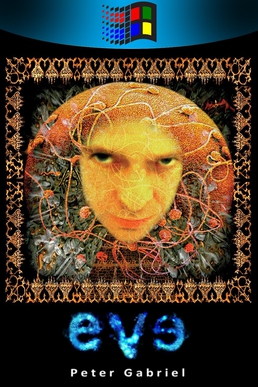
Peter Gabriel: Eve, also known as simply Eve, is a music and art adventure video game directed by Michael Coulson and co-produced by the Starwave Corporation, developed and published by Real World Multimedia for Windows and Macintosh in 1996–1997. It was created in association with and featuring the music of Peter Gabriel.




















